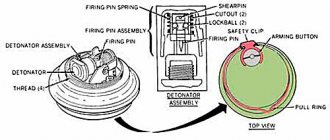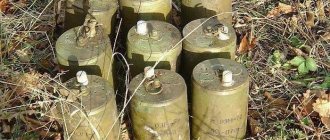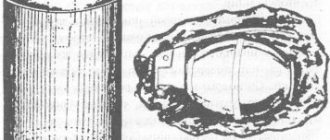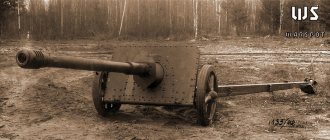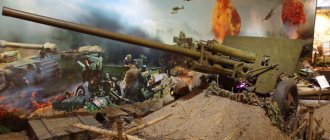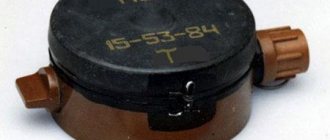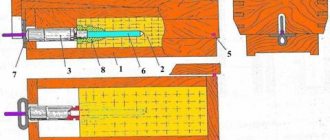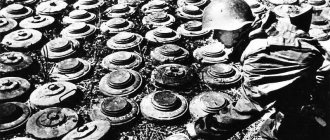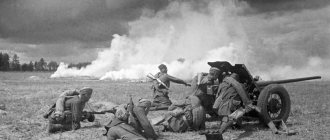German magnetic cumulative anti-tank mine HHL 3 or Haft - H3
The German magnetic
anti-tank, cumulative
mine
known with the Hans name as Hafthohlladung 3, is essentially a shaped charge attached to armor (the abbreviated name of which is HHL 3 or Haft - H3) is mainly intended for the destruction of armored vehicles, light and medium tanks of the enemy and is a modernized model of conventional cumulative combat mines, which received the common name Panzerhandminen (Panzerhandminen)
was more modern than the earlier one, adopted in 1942, during the Second World War, the year it was adopted by Wehrmacht infantry units and troops, a hand-held cumulative mine known as Panzerhandmine 3 (abbreviated PzHM 3) and had 3 powerful magnets, making it possible to attach it almost anywhere on enemy equipment.
The Hafthohlladung 3 hand-held cumulative mine consists of: an explosive charge placed in a metal casing - mainly hexogen, 3 permanent magnets and a fuse designed to detonate this anti-tank ammunition. The body of the mine is made of thin metal and consists of main parts fastened to each other - cylindrical and conical. A mine was also manufactured with a body in the form of a hemisphere, in which an explosive charge was placed, and in this version the mine had a large penetration thickness, and, accordingly, weight and dimensions. The upper part had a special threaded hole into which the fuse was screwed. A warhead was placed in a funnel made of thin sheet iron.
Using ordinary threaded screws, the case is attached to an ebonite plate, on which three strong magnets have found their place, withstanding a tearing force of 45 kg. During transportation, they are covered with a non-magnetic plate to avoid demagnetization. The TNT charge was placed inside the mine body and consists of two main blocks. An additional detonator was installed in the rear part of the body, and the main combat charge was placed in the conical part. Haft - H3 were equipped with a standard grating fuse with the index BZE 39 (in decoding Brennzunder Eifer 39) complete with a Sprengkapsel N.8 detonator capsule from the Eihandgranaten 39 (M-39) infantry hand grenade, simply called an egg. The burning time of the moderator was slightly less than 5 seconds when using fuses with a blue cap (in the instructions for using the mine they are indicated as old-style fuses), and new-style fuses with a yellow cap burned for up to 7 seconds. The grating fuse itself was assembled in a housing that housed a grating block with an explosion moderator and a detonator capsule. To fire the fuse, it was necessary to unscrew the cap and sharply pull it, holding it between the fingers or in the palm. In this case, the grater ignites the moderator and after its combustion, the detonator is activated and an explosion occurs.
For combat use of Hafthohlladung 3 you need:
1. unscrew the safety cap from the fuse thread 2. put a combat detonator cap on a special sleeve 3. screw the fuse into the socket located on the grenade body 4. unscrew the fuse cap, hold it in your fist, passing a silk cord between your fingers 5. jerk out the cord with the internal grater 6. quickly attach the mine to the enemy tank and go for cover.
To install a magnetic mine, the soldier quietly approached the enemy tank as close as possible, taking advantage of the so-called “dead” space around the target and folds in the terrain. The Haft-H3 cumulative mine on three magnets could be attached to almost any point on the tank’s hull, mainly opposite the most vulnerable spots (engine, opposite ammunition, fuel tanks, gun mantlet). In some cases, it was recommended to use a chain with a special hook to prevent the mine from being dropped from its intended location. After activation, the cumulative jet under high pressure pressed through up to 150 mm of tank armor. If the Germans knew about the night tank attack of the Soviet troops, then they removed all their armored vehicles from the battlefield and gave the soldiers magnetic cumulative hand mines and the soldiers did not need to distinguish their tanks from enemy armored vehicles - they destroyed everything that rattled and moved. In addition, Hafthohlladung 3, when destroying pillboxes, bunkers, armored caps, armored shutters, a physically strong fighter could be thrown at a distance of up to 15 meters, but in this case the effect of the mine was reduced
TTX
Mine weight - 3500 kg. The mass of the explosive is 1700 grams. Explosive type - hexogen. Transverse size 150 mm. Grenade height, mm275 / 300 mm. Cumulative armor penetration - 180 mm Deceleration time - from 4.5 to 7.0 seconds.
The most unusual mines: 7 cunning devices for destroying infantry and equipment
The great commander Sun Tzu once said, “The art of war is based on lies.” Therefore, if there is a way to destroy the enemy or make his life as difficult as possible without putting your troops in danger, they usually use it. And all kinds of traps are an ideal means for this. And where there are traps, there are their more advanced versions - explosive devices. And today we will tell you about the most unusual mines that were actively used to destroy enemy personnel and equipment.
The content of the article
"Goliath"
Or Sonder Kraftfahrzeug, as its creators, the Wehrmacht gunsmiths, called it. " Goliath " is a remote-controlled self-propelled mine. In its time it cost about 1000 Reichsmarks - not so much. Carried from 75 to 100 kg of explosives. Against IS, this, of course, was not enough, but less armored vehicles were destroyed perfectly.
The disadvantage was that the self-propelled, but not very maneuverable and passable wedge was quite easy to shoot - the light armor only saved it from hand-held firearms. But all you have to do is break the control wire - that’s it, you have a useless piece of iron at your disposal. This unusual mine was produced throughout the war, and towards the end they reduced the price and increased the amount of explosives, but in general, they were dissatisfied with it.
Magnetic mine Hafthohlladung
The purpose of this unusual mine was extremely simple - to open armor up to 140 mm. Or concrete up to half a meter. Even the legendary IS-2 found this unpleasant. Neither inclined surfaces nor other cunning devices helped, since the mine hit clearly at a right angle and with a focused shock stream.
Method of application: the magnetic mine had to be manually placed on the surface of the tank. And then you had 4.5 seconds to get to a safe distance. This thing weighed 3 kg. To understand how Hafthohlladung was, it is enough to know that during the Second World War something like half a million of them were produced. By comparison, the super-efficient jumping S-mines were produced in quantities of almost 2 million.
Kugeltreibmine - round mine made of concrete
Kugeltreibmine is a twenty-kilogram concrete ball, 25 cm in diameter, filled with almost a kilogram of TNT and a bunch of metal parts. There was no rescue within a radius of 10 meters. And just the prospect of getting hit in the head with a concrete ball is so-so.
That’s exactly how it worked - the sappers carefully unscrewed the clamps, and the mines rolled down the slope. After 10-12 seconds they exploded. The mine was quite effective, but very highly specialized. Therefore it was rarely used.
PMP (anti-personnel bullet mine)
At the beginning of the Great Patriotic War, the USSR was technically quite far behind its enemy. Therefore, the emphasis had to be on simplicity, versatility and mass appeal.
The PMP is the most primitive pressure-action mine, which only requires a kilogram of force. And this pressing triggered a simple system that pierced the primer of the 7.62×25 cartridge. A shot, a crushed foot, a fighter losing his fighting ability. And remaining disabled is simple, effective, cruel. It is impossible to defuse the mine; it is difficult to detect it, since its dimensions are small and its weight is 150 grams.
Anti-tank strike mine Ni05
And this unusual mine is already from the Pacific Front. The essence of Ni05 is simple - there are three kilograms of TNT, there is a contact fuse. And there is a stalk of one and a half meters, at one end of which there is a mine, and at the other, a rather fanatical Japanese. You need to approach, hit the armor, and go to another world, taking the enemy vehicle with you.
The explosion was guaranteed to penetrate 15 cm of armor, since the mine was not used against the relatively protected bottom or frontal armor, but against much less durable sides. However, there was not much information about the effective use of such unusual mines. But overall, it worked.
"Sea Dragon King"
The Chinese military treatise Holongjing from the XIV (fourteenth, damn it) century contains a description of an almost classic sea mine. An explosive that is sealed in a container and floats below the water line. There was even a remote fuse - a Chinese man sitting on the shore and holding a long blasting cord, which only had to be pulled out to fire a simple silicon fuse.
Similar designs were also mentioned in 1637, with examples of real combat use - against river pirates.
"Garlic"
“Garlic” is not a mine in its direct sense, since no explosives were used in this device. But in essence, it is a weapon for mass destruction of enemy infantry. Steel pointed hooks in the shape of a tetrahedron. The enemy advances and never goes anywhere else. And if you also supply the pins with jagged edges, then getting this “mine” becomes extremely difficult.
These things were actively used by troops all over the world - only the British called them caltrops, the Japanese - makibishi, and the ancient Romans and Byzantines - Murex ferreus and tribola.
Interestingly, in the famous Battle of Borodino, “garlic” was very actively used. Something like 72 thousand poods, according to official data. And this is approximately 1179 and a half tons of sharpened steel pins. By the way, they worked not so much against humans as against horses. If the wounded man could still be returned to duty, then the horse with an injured hoof was usually finished off.
Well, then we can recall the numerous “hellish” devices and traps that the inventive Vietnamese made day and night in order to exterminate more of the American adversary during the years of the Vietnam War. But this is the topic of a separate article, and more than one. Therefore, today we will focus on “Garlic”.
Thanks for taking the time to read. And as usual, we ask for discussion in the comments. Well, add if you also know what cunning mines and traps from the history of war and the world of mankind.
